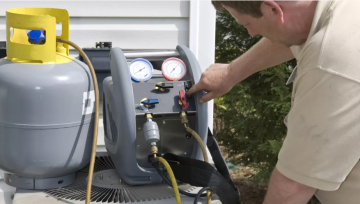Woodcliff Lake, NJ – January 25, 2024 – Refrigerants are essential for our economy and well-being. Our food supply depends on refrigeration at every stage of the “cold chain” to safely bring perishable food to the supermarket. Refrigerants are made to absorb and transfer heat. In your home and in supermarkets, refrigerators absorb heat and transport it to the outside, keeping food cold. In your home, your air conditioner (AC) or heat pump does the same thing: Refrigerants inside your AC or heat pump absorb heat from the outside and bring it inside to heat the house, and the other way around to cool the house.
Ironically, the things that keep us cool are also warming us up. Most of the refrigerants used today are among the worst offenders when it comes to global warming. Fluorinated refrigerant gases are used in our ACs, heat pumps, and supermarkets—most of them, hydrofluorocarbons (HFCs)—and they are 2,000 to 4,000 times more potent than carbon dioxide (CO2) in warming the planet, if released into the atmosphere.
Many refrigeration systems, ACs, and heat pumps installed today will be operating for the next two decades. In an ideal world, as old systems retire, the refrigerants inside them would be recovered, cleaned up (the technical term is reclaimed), and reused to service the equipment that still needs the old refrigerants to run. Refrigerant gases can be reused after cleaning and separation, and there is a robust nationwide industry providing refrigerant reclamation services for big users.
But one of the main problems is refrigerant recovery. Most of the refrigerants are being vented instead of recovered, mainly because of a lack of incentives for technicians to take this simple step. This means there isn’t enough recovered refrigerant to reclaim in the United States today. The U.S. Environmental Protection Agency (EPA) is trying to fix that. As part of the HFC phasedown, the EPA is planning to require the industry to use increasing amounts of reclaimed refrigerants because it helps reduce the demand for newly produced HFCs and minimizes their release into the atmosphere. The proposed regulation is aimed at creating market demand for reclaimed refrigerants that will, in turn, lead to greater recovery and minimize releases to the atmosphere. But time is short, and we need other mechanisms that boost refrigerant recovery, especially as we approach the next steps in the HFC phasedown.
Ruth Ivory-Moore of Hudson Technologies testified,
“A bounty will go a long way to incentivizing a greater supply of recovered refrigerant, which can then be reclaimed and reused.”
To read more about the NRDC’s view on the life-cycle management of refrigerants and reclamation, click here.


